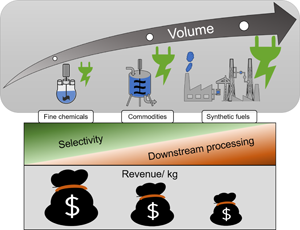Crossref Citations
This article has been cited by the following publications. This list is generated based on data provided by
Crossref.
Klein, Martin
and
Waldvogel, Siegfried R.
2021.
Anodic Dehydrogenative Cyanamidation of Thioethers: Simple and Sustainable Synthesis of N‐Cyanosulfilimines.
Angewandte Chemie International Edition,
Vol. 60,
Issue. 43,
p.
23197.
Klein, Martin
and
Waldvogel, Siegfried R.
2021.
Anodische dehydrierende Cyaniminierung von Thioethern: eine einfache und nachhaltige Synthese von N‐Cyansulfiliminen.
Angewandte Chemie,
Vol. 133,
Issue. 43,
p.
23382.
Dörr, Maurice
Hielscher, Maximilian M.
Proppe, Jonny
and
Waldvogel, Siegfried R.
2021.
Electrosynthetic Screening and Modern Optimization Strategies for Electrosynthesis of Highly Value‐added Products.
ChemElectroChem,
Vol. 8,
Issue. 14,
p.
2621.
Dell'Anna, Marco Nazareno
Laureano, Mathew
Bateni, Hamed
Matthiesen, John E.
Zaza, Ludovic
Zembrzuski, Michael P.
Paskach, Thomas J.
and
Tessonnier, Jean-Philippe
2021.
Electrochemical hydrogenation of bioprivilegedcis,cis-muconic acid totrans-3-hexenedioic acid: from lab synthesis to bench-scale production and beyond.
Green Chemistry,
Vol. 23,
Issue. 17,
p.
6456.
Blum, Stephan P.
Nickel, Christean
Schäffer, Lukas
Karakaya, Tarik
and
Waldvogel, Siegfried R.
2021.
Electrochemical Nitration with Nitrite.
ChemSusChem,
Vol. 14,
Issue. 22,
p.
4936.
Beil, Sebastian B.
Pollok, Dennis
and
Waldvogel, Siegfried R.
2021.
Reproduzierbarkeit in der elektroorganischen Synthese – Mythen und Missverständnisse.
Angewandte Chemie,
Vol. 133,
Issue. 27,
p.
14874.
Beil, Sebastian B.
Pollok, Dennis
and
Waldvogel, Siegfried R.
2021.
Reproducibility in Electroorganic Synthesis—Myths and Misunderstandings.
Angewandte Chemie International Edition,
Vol. 60,
Issue. 27,
p.
14750.
Wirtanen, Tom
Prenzel, Tobias
Tessonnier, Jean-Philippe
and
Waldvogel, Siegfried R.
2021.
Cathodic Corrosion of Metal Electrodes—How to Prevent It in Electroorganic Synthesis.
Chemical Reviews,
Vol. 121,
Issue. 17,
p.
10241.
Blum, Stephan P.
Schäffer, Lukas
Schollmeyer, Dieter
and
Waldvogel, Siegfried R.
2021.
Electrochemical synthesis of sulfamides.
Chemical Communications,
Vol. 57,
Issue. 39,
p.
4775.
Blum, Stephan P.
Hofman, Kamil
Manolikakes, Georg
and
Waldvogel, Siegfried R.
2021.
Advances in photochemical and electrochemical incorporation of sulfur dioxide for the synthesis of value-added compounds.
Chemical Communications,
Vol. 57,
Issue. 67,
p.
8236.
Breiner, Manuel
Zirbes, Michael
and
Waldvogel, Siegfried R.
2021.
Comprehensive valorisation of technically relevant organosolv lignins via anodic oxidation.
Green Chemistry,
Vol. 23,
Issue. 17,
p.
6449.
Seidler, Johannes
Bernhard, Rebecca
Haufe, Stefan
Neff, Caroline
Gärtner, Tobias
and
Waldvogel, Siegfried R.
2021.
From Screening to Scale-Up: The DoE-Based Optimization of Electrochemical Reduction of l-Cystine at Metal Cathodes.
Organic Process Research & Development,
Vol. 25,
Issue. 12,
p.
2622.
Hielscher, Maximilian
Oehl, Elisabeth K.
Gleede, Barbara
Buchholz, Julian
and
Waldvogel, Siegfried R.
2021.
Optimization Strategies for the Anodic Phenol‐Arene Cross‐Coupling Reaction.
ChemElectroChem,
Vol. 8,
Issue. 20,
p.
3904.
Wu, Jianzhong
2022.
Microscopic principles of chemical engineering after fossil fuels.
Resources Chemicals and Materials,
Vol. 1,
Issue. 3-4,
p.
222.
Cantillo, David
2022.
Synthesis of active pharmaceutical ingredients using electrochemical methods: keys to improve sustainability.
Chemical Communications,
Vol. 58,
Issue. 5,
p.
619.
Britschgi, Joel
Kersten, Wolfgang
Waldvogel, Siegfried R.
and
Schüth, Ferdi
2022.
Electrochemically Initiated Synthesis of Methanesulfonic Acid.
Angewandte Chemie International Edition,
Vol. 61,
Issue. 41,
Xia, Jinwen
Liu, Xiaojun
Sun, Dongqi
Li, Chenxi
and
Wang, Zhaofei
2022.
Energy Consumption Connection of Industrial Sector Based on Industrial Link Theory: A Case Study of China.
Frontiers in Ecology and Evolution,
Vol. 10,
Issue. ,
Beck, Alexander D.
Schäffer, Lukas
Haufe, Stefan
and
Waldvogel, Siegfried R.
2022.
Assessment of the Electrochemical Synthesis Route to Silicones Starting from Silica as Feedstock.
European Journal of Organic Chemistry,
Vol. 2022,
Issue. 47,
Britschgi, Joel
Kersten, Wolfgang
Waldvogel, Siegfried R.
and
Schüth, Ferdi
2022.
Electrochemically Initiated Synthesis of Methanesulfonic Acid.
Angewandte Chemie,
Vol. 134,
Issue. 41,
Gombos, Lilla G.
and
Waldvogel, Siegfried R.
2022.
Electrochemical Bromofunctionalization of Alkenes and Alkynes—To Sustainability and Beyond.
Sustainable Chemistry,
Vol. 3,
Issue. 4,
p.
430.






